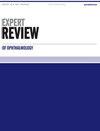从眼睛窥视大脑的窗户:OCT血管造影术在痴呆症中的潜在应用
IF 0.9
Q4 OPHTHALMOLOGY
引用次数: 0
摘要
痴呆症被定义为由于进行性神经退行性变而导致的后天认知能力(执行功能、记忆、语言、视觉空间和运动)的不可逆转的恶化。根据世界卫生组织(世界卫生组织)2018年的一份报告,痴呆症是全球最常见的7种死亡原因。2018年,全球估计患有痴呆症的人数为5000万,预计到2050年这一数字将增加两倍[1]。全球人口迅速老龄化以及由此导致的痴呆症发病率空前上升,预计将给欠发达国家和发达国家的医疗支出带来更大的负担。光学相干断层扫描血管造影术(OCT-A)是一种无创且简便的方法,用于观察视网膜和脉络膜微循环,无需使用全身造影剂。与其他大脑成像方式(如正电子发射断层扫描成像)相比,它更具成本效益,并且可以快速逐层评估视网膜脉络膜微循环。在常规视网膜临床中,OCT-a主要用于年龄相关性黄斑变性和糖尿病视网膜病变的诊断和监测。它也已成为评估青光眼和其他视神经病变乳头周围和黄斑微循环的流行研究工具,希望找到各种血管线索,从而能够早期诊断和/或检测疾病进展[2]。除了在繁忙的眼科诊所中发挥不可或缺的作用外,研究表明,OCT-a在直接或间接影响视网膜和/或绒毛膜毛细血管微循环的各种其他非眼科疾病中可能是一种非常有用的辅助工具,如多发性硬化症、帕金森氏症和阿尔茨海默氏症[3]。本文章由计算机程序翻译,如有差异,请以英文原文为准。
A peek at the window from the eye into the brain: potential use of OCT angiography in dementia
Dementia is defined as the irreversible deterioration of acquired cognitive abilities (executive functions, memory, language, visuospatial, and motor) because of progressive neurodegeneration. According to a report by the World Health Organization (WHO) in 2018, dementia ranks as the 7 most common worldwide cause of death. In 2018, the globally estimated number of people afflicted by dementia was 50 million, a figure which is expected to triple by the year 2050 [1]. The worldwide rapidly aging population and the resultant unprecedented rise in the incidence of dementia are anticipated to cause a greater burden in health expenditures both in underdeveloped and developed countries alike. Optical coherence tomography angiography (OCT-A) is a noninvasive and facile method for visualizing retinal and choroidal microcirculation obviating the need for administering a systemic contrast agent. Compared to other brain imaging modalities, such as positron emission tomography imaging, it is more cost-effective and rapidly allows layer-bylayer assessment of retinochoroidal microcirculation. In a routine retina clinic, OCT-A is mainly employed for the diagnosis and monitoring of age-related macular degeneration and diabetic retinopathy. It has also become a popular research tool for assessing peripapillary and macular microcirculation in glaucoma and other optic neuropathies with the hope of finding various vascular cues that may enable earlier disease diagnosis and/or the detection of its progression [2]. In addition to its indispensable role in a busy ophthalmology clinic, studies have shown that OCT-A may potentially be a highly useful ancillary tool in various other non-ophthalmic diseases that directly or indirectly impact retinal and/or choriocapillaris microcirculation, such as multiple sclerosis, Parkinson’s, and Alzheimer’s diseases [3].
求助全文
通过发布文献求助,成功后即可免费获取论文全文。
去求助
来源期刊

Expert Review of Ophthalmology
Health Professions-Optometry
CiteScore
1.40
自引率
0.00%
发文量
39
期刊介绍:
The worldwide problem of visual impairment is set to increase, as we are seeing increased longevity in developed countries. This will produce a crisis in vision care unless concerted action is taken. The substantial value that ophthalmic interventions confer to patients with eye diseases has led to intense research efforts in this area in recent years, with corresponding improvements in treatment, ophthalmic instrumentation and surgical techniques. As a result, the future for ophthalmology holds great promise as further exciting and innovative developments unfold.
 求助内容:
求助内容: 应助结果提醒方式:
应助结果提醒方式:


